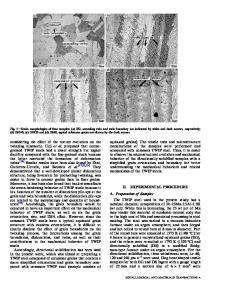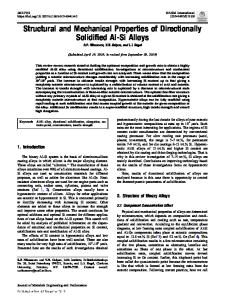The mechanical behavior of directionally solidified Al-Ni in compression
- PDF / 1,790,477 Bytes
- 7 Pages / 597.28 x 785 pts Page_size
- 58 Downloads / 317 Views
I.
INTRODUCTION
T H E R E is a very extensive literature on the growth and mechanical properties o f directionally solidified materials including the system A1-Ni. L1-5] The increase in interest in metal matrix composites has led to the need not only to understand the basic strengthening mechanisms in metal matrix composites containing elongated fibers but to consider their intrinsic anisotropy and their limitations with regard to fracture and instability processes. The current work was performed on a directionally solidified A1-6 pct Ni in order to examine how the fibers o f A13Ni constrain the flow o f the ductile matrix for a loading axis other than one parallel to the intermetallic fibers and to examine the process o f buckling and failure when the composite is loaded in compression along the fiber axis.
II.
EXPERIMENTAL DETAILS
An AI-6 pct Ni alloy (6.08Ni, 0.21Si, 0.042Fe, 0.016Mg, 0.003Cu, 0.003Zn, 0.001Ti, 0.001Mn, balance A1, in weight percent) was directionally solidified in a Bridgeman-type furnace at a rate o f 5 cm/h using a 3-cm-diameter graphite crucible. Samples were subsequently polished and etched in a solution o f 1 pct HF, 1.5 pct HC1, and 2.5 pct HNO3. The microstructure o f the directionally solidified material in the composite is shown in Figures l(a) and (b). Two important features o f the composite are illustrated in Figure 1, n a m e l y , the formation o f cells o f the order o f 0.5 mm in diameter and the average inclination o f the fibers at angles o f the order o f 4 to 6 deg to the growth axis. This angle o f inclination was determined by careful metallographic studies o f a n u m b e r of fields in w h i c h the growth axis was used as a reference direction. The volume fraction of the A13Ni fibers has been measured using an automatic image analyzer to be 10 -+ 2.3 pct, and the mean aspect ratio measured on a longitudinally sectioned plane is 20 - 4.7. Cylindrical samples o f 10 mm in diameter and 5, 10, S. TAO, Research Associate, is with the Department of Metallurgical Engineering, Queen's University, Kingston, ON K7L 3N6, Canada. J.D. EMBURY, Professor, is with the Department of Materials Science and Engineering, McMaster University, Hamilton, ON L 8 S 4 L 7 , Canada. Manuscript submitted May 2 6 , 1 9 9 2 . METALLURGICAL TRANSACTIONS A
and 15 mm in height were machined from the directionally solidified material with the fiber axis parallel to the compression axis and at angles o f 30, 45, and 90 deg between the fiber and compression a x e s . The majority o f compression tests were conducted at room temperature, but some tests were conducted at - 6 0 °C and - 160 °C using suitable constant temperature liquids. All tests were performed at a crosshead speed o f 1 m m / m i n on an MTS testing machine. III.
RESULTS
F o r clarity, the results are reported in three subsections. The first deals with the orientation dependence o f yielding in compression, the second with the process of kinking and fracture for samples compressed along the fiber axis, and the third with deductions
Data Loading...










